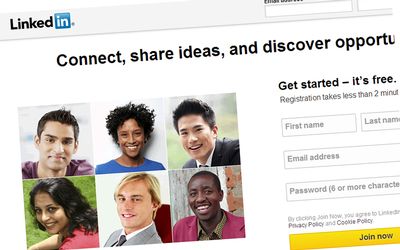Source:

How small businesses are getting LinkedIn wrong
by Alexandra Samuel,
2016-01-25 18:14:50.0
How can a small company make the most of LinkedIn?
The social network is an inescapable part of online life for working professionals. But much of the advice on how to leverage it is targeted at big names. Over and over, I see small businesses making mistakes on LinkedIn because they are patterning their strategies after approaches that work for larger companies with huge budgets, lots of brand awareness and extensive social-media systems.
With that in mind, here are tips on how small businesses can use LinkedIn.
Don’t use it for marketing. Smaller companies need to be strategic about where they invest their content-marketing budgets. Many businesses can get more bang for the buck on Facebook, Pinterest or Instagram, where consumers spend a lot more time and attention, or with Twitter or an independent blog, where it’s easier to showcase expertise. By all means, cross-post the occasional article or update to LinkedIn, but focus on it as a source of connections and expertise — not as a way of building an audience or brand awareness.
Tap your network for trips. While large companies may have sales teams in multiple cities, small firms must squeeze the most out of every business trip. Once salespeople book the meetings and events that constitute the primary purpose of a trip, they should use LinkedIn to fill the calendar with more meetings. They can use the geographic-search option to search first-and second-degree connections in the destination city and filter results to people whose job titles, company size and industry match a typical sales target. Then they can ask common connections for an intro.
Don’t help competitors. It’s great to have collegial relationships with other people in your field. But when connecting on LinkedIn, it pays to be a little cutthroat. If small-business people accept collegial connection requests from people who work for competitors, they are making their entire network accessible to the competition. In a small town or industry, some exposure is inevitable, but there’s no reason to make competitors’ work easier for them by accepting their connection requests.
Keep critical activity private. Because LinkedIn lets Premium members see who has recently viewed their profile, it’s easy to end up overexposed when investigating a prospect or competitor. That’s a lot riskier for a small company than it would be for a well-established brand. So if small-business people don’t want somebody to know they’re looking at their profile, they should open a private browsing window. Conversely, small-business people should be sure to look periodically at who has viewed their profile, because it may provide useful insights into their own business.
Don’t focus on lead generation. A sales team should use LinkedIn to identify prospects; a small company can make that easier by encouraging everyone in the company to connect with one another on LinkedIn, so that they share networks. But they shouldn’t expect their company page to be a source of inbound leads if they don’t have the kind of advertising budget that big companies use to drive LinkedIn traffic. Instead, a small firm should polish and update its page only often enough to attest to its credentials, professionalism and experience.
Sell the business, not yourself. On LinkedIn, brand matters more than title. People who work at big, recognised companies have an advantage, because their profile summaries can immediately convey their role and industry. At a small company, a C-level title doesn’t mean much. Small-business executives should include a descriptive summary of their business, leveraging the brand of top clients, like "chief financial officer of Acme Accounting, financial advisers to The Gap and Target."
Likewise, for founders, executives or principals in a small business, a profile needs to tell a story that’s bigger than their own career: It needs to tell the story of the business or brand. An exec can weave the two narratives together by showing the value the company brings to customers and noting the contributions the exec has made to that effort.
Get focused when hiring. Big companies can afford to post openings on LinkedIn, and then wait for applicants. Lesser-known companies need to work harder to attract the best applicants, and may do better by searching for qualified candidates (and then checking them out by calling contacts in common). If a small firm knows a couple of people who represent its dream hire, the firm should use their LinkedIn profiles to reverse-engineer a dream applicant: What are the roles and experiences those dream candidates had before they landed in their current positions? The firm can then search for people who hold similar positions, and assemble a candidate pool.
Ask for help. Bidding on a government contract for the first time? Instead of hiring a consultant, ask the LinkedIn network for its collective wisdom. Need a new supply-chain management tool? Skip the costs of commissioning an assessment, and ask LinkedIn pals what they are using. Joining LinkedIn groups can help small-business people broaden the range of expertise they can access. But this approach only works for people who are generous helpers in turn: Users should make sure they check into each of their key groups at least monthly, and try to offer help on questions where they have insight.
* Samuel is an independent technology researcher and the author of Work Smarter with Social Media.
More Africa news from The Wall Street Journal
More news from The Wall Street Journal
Premium access to WSJ.com: $1 a week for 12 weeks

Picture: BUSINESS DAY
How can a small company make the most of LinkedIn?
The social network is an inescapable part of online life for working professionals. But much of the advice on how to leverage it is targeted at big names. Over and over, I see small businesses making mistakes on LinkedIn because they are patterning their strategies after approaches that work for larger companies with huge budgets, lots of brand awareness and extensive social-media systems.
With that in mind, here are tips on how small businesses can use LinkedIn.
Don’t use it for marketing. Smaller companies need to be strategic about where they invest their content-marketing budgets. Many businesses can get more bang for the buck on Facebook, Pinterest or Instagram, where consumers spend a lot more time and attention, or with Twitter or an independent blog, where it’s easier to showcase expertise. By all means, cross-post the occasional article or update to LinkedIn, but focus on it as a source of connections and expertise — not as a way of building an audience or brand awareness.
Tap your network for trips. While large companies may have sales teams in multiple cities, small firms must squeeze the most out of every business trip. Once salespeople book the meetings and events that constitute the primary purpose of a trip, they should use LinkedIn to fill the calendar with more meetings. They can use the geographic-search option to search first-and second-degree connections in the destination city and filter results to people whose job titles, company size and industry match a typical sales target. Then they can ask common connections for an intro.
Don’t help competitors. It’s great to have collegial relationships with other people in your field. But when connecting on LinkedIn, it pays to be a little cutthroat. If small-business people accept collegial connection requests from people who work for competitors, they are making their entire network accessible to the competition. In a small town or industry, some exposure is inevitable, but there’s no reason to make competitors’ work easier for them by accepting their connection requests.
Keep critical activity private. Because LinkedIn lets Premium members see who has recently viewed their profile, it’s easy to end up overexposed when investigating a prospect or competitor. That’s a lot riskier for a small company than it would be for a well-established brand. So if small-business people don’t want somebody to know they’re looking at their profile, they should open a private browsing window. Conversely, small-business people should be sure to look periodically at who has viewed their profile, because it may provide useful insights into their own business.
Don’t focus on lead generation. A sales team should use LinkedIn to identify prospects; a small company can make that easier by encouraging everyone in the company to connect with one another on LinkedIn, so that they share networks. But they shouldn’t expect their company page to be a source of inbound leads if they don’t have the kind of advertising budget that big companies use to drive LinkedIn traffic. Instead, a small firm should polish and update its page only often enough to attest to its credentials, professionalism and experience.
Sell the business, not yourself. On LinkedIn, brand matters more than title. People who work at big, recognised companies have an advantage, because their profile summaries can immediately convey their role and industry. At a small company, a C-level title doesn’t mean much. Small-business executives should include a descriptive summary of their business, leveraging the brand of top clients, like "chief financial officer of Acme Accounting, financial advisers to The Gap and Target."
Likewise, for founders, executives or principals in a small business, a profile needs to tell a story that’s bigger than their own career: It needs to tell the story of the business or brand. An exec can weave the two narratives together by showing the value the company brings to customers and noting the contributions the exec has made to that effort.
Get focused when hiring. Big companies can afford to post openings on LinkedIn, and then wait for applicants. Lesser-known companies need to work harder to attract the best applicants, and may do better by searching for qualified candidates (and then checking them out by calling contacts in common). If a small firm knows a couple of people who represent its dream hire, the firm should use their LinkedIn profiles to reverse-engineer a dream applicant: What are the roles and experiences those dream candidates had before they landed in their current positions? The firm can then search for people who hold similar positions, and assemble a candidate pool.
Ask for help. Bidding on a government contract for the first time? Instead of hiring a consultant, ask the LinkedIn network for its collective wisdom. Need a new supply-chain management tool? Skip the costs of commissioning an assessment, and ask LinkedIn pals what they are using. Joining LinkedIn groups can help small-business people broaden the range of expertise they can access. But this approach only works for people who are generous helpers in turn: Users should make sure they check into each of their key groups at least monthly, and try to offer help on questions where they have insight.
* Samuel is an independent technology researcher and the author of Work Smarter with Social Media.
More Africa news from The Wall Street Journal
More news from The Wall Street Journal
Premium access to WSJ.com: $1 a week for 12 weeks



















Change: 2.48%
Change: 2.53%
Change: 2.08%
Change: 1.97%
Change: 5.33%
Data supplied by Profile Data
Change: 0.00%
Change: 0.00%
Change: 2.48%
Change: 0.00%
Change: 0.00%
Data supplied by Profile Data
Change: 0.44%
Change: 0.11%
Change: -0.76%
Change: -0.92%
Change: -0.23%
Data supplied by Profile Data
Change: 0.00%
Change: 0.00%
Change: 0.00%
Change: 0.00%
Change: 0.00%
Data supplied by Profile Data